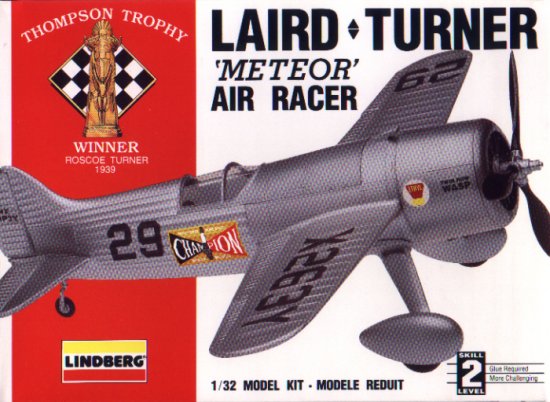
Lindberg 1/32 Laird-Turner Meteor Air Racer
|
KIT # |
70562 |
|
PRICE: |
$7.50 (in 1992) |
|
DECALS: |
1939 Thompson Trophy Winner |
|
REVIEW & PHOTOS BY: |

|
HISTORY |
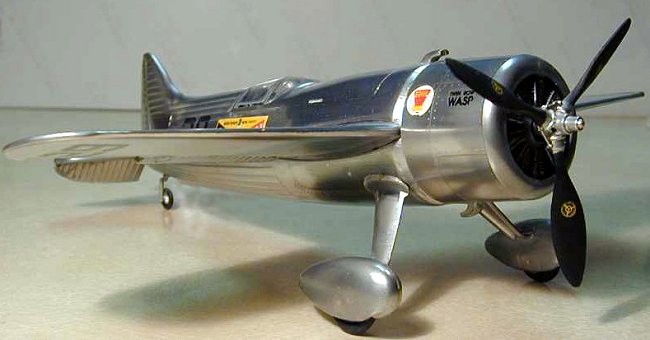
The 1930s were considered the “Golden Age of Aviation.” During this time, aircraft design evolved significantly. One of the driving forces behind this evolution was air racing. Numerous pilots poured money and time into developing faster and faster airplanes, in order to compete for the prestige of being the fastest man in the air. One such pilot was Roscoe Turner.
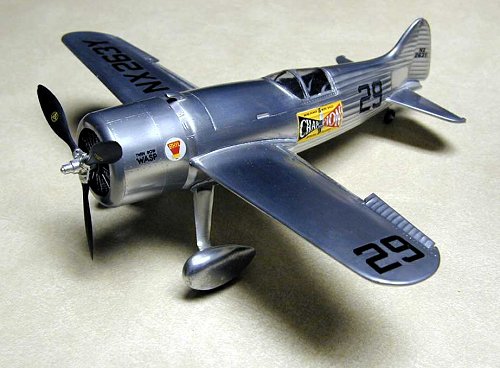 Born near
Corinth, Mississippi in 1895, Roscoe Turner grew up with a thirst for speed. He
became a pilot, and after a varied career in aviation, began racing in 1928. By
1935, he had already won both the Bendix and Thompson trophies, but the need for
greater speed was gnawing at him. In 1936, Turner
contracted with the Lawrence W. Brown Aircraft Company in California to build
him a new racer. Turner designed the airplane himself and Professor Howard
Barlow of the University of Minnesota engineered it. The design was a full
cantilever, mid-wing monoplane with fixed gear. Since Turner was convinced that
power would overcome aerodynamics in racing, the airplane was powered by a great
big honkin’ Twin Wasp Sr., 1830 cu. in. 1000 hp. radial engine, which gave the
airplane its unusual shape (i.e., virtually all engine, similar to the Gee Bee
design).
Born near
Corinth, Mississippi in 1895, Roscoe Turner grew up with a thirst for speed. He
became a pilot, and after a varied career in aviation, began racing in 1928. By
1935, he had already won both the Bendix and Thompson trophies, but the need for
greater speed was gnawing at him. In 1936, Turner
contracted with the Lawrence W. Brown Aircraft Company in California to build
him a new racer. Turner designed the airplane himself and Professor Howard
Barlow of the University of Minnesota engineered it. The design was a full
cantilever, mid-wing monoplane with fixed gear. Since Turner was convinced that
power would overcome aerodynamics in racing, the airplane was powered by a great
big honkin’ Twin Wasp Sr., 1830 cu. in. 1000 hp. radial engine, which gave the
airplane its unusual shape (i.e., virtually all engine, similar to the Gee Bee
design).
Turner entered his new racer, dubbed the “R-14 Meteor”, in the 1937 National Air Races (Thompson Race) and was in the lead until the final lap, when he had to recircle a pylon he had missed. Nevertheless, Turner placed third with a speed of 253.8 mph.
Turner, sponsored by Pump Engineering Service Corporation or “Pesco”, entered the Meteor in the 1938 Nationals and this time he won (speed: 283.4 mph), becoming the first two-time winner of the Thompson Trophy. In 1939, Champion Spark Plugs sponsored Turner and the Meteor in the Nationals. At this race, Turner won his third Thompson Trophy with a speed of 282.5 mph, and then announced his retirement from racing. Turner subsequently returned to Indianapolis to operate the Turner Aeronautical Corporation until he died in 1970.
The Meteor hung from the rafters of the company’s main hangar until it was restored and placed in the Turner Museum in Indianapolis. When the museum closed in 1972, Turner’s Meteor was donated to the National Air and Space Museum, where it now resides at NASM ‘s Garber Facility in Suitland, Maryland.
|
THE KIT |
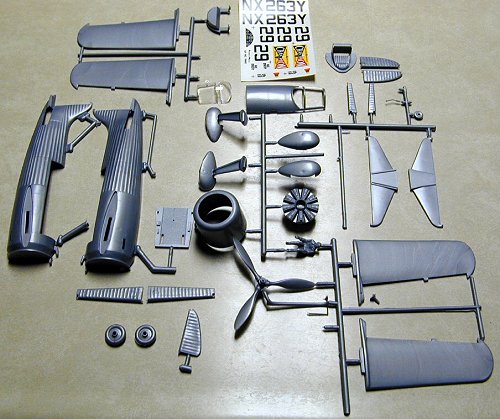 Released in 1992, the Lindberg 1/32 kit of this famous airplane is a very
simple build, yet looks pretty good once constructed. On opening the box, one is
greeted by the starkness of the kit, typical of the older days. The kit consists
of only 33 parts molded in silver plastic and two clear plastic parts. The kit
includes a very simple decal sheet for Roscoe Turner’s 1939 Thompson Trophy
winner, but based on the photos I’ve seen of the real aircraft, they are
accurate.
Released in 1992, the Lindberg 1/32 kit of this famous airplane is a very
simple build, yet looks pretty good once constructed. On opening the box, one is
greeted by the starkness of the kit, typical of the older days. The kit consists
of only 33 parts molded in silver plastic and two clear plastic parts. The kit
includes a very simple decal sheet for Roscoe Turner’s 1939 Thompson Trophy
winner, but based on the photos I’ve seen of the real aircraft, they are
accurate.
The cockpit is rather sparse, and there is an equally uninspired decal provided for the instrument panel. The engine, which looks reasonable once it’s mounted in the model, is molded as a single piece, as is the three bladed prop. All panel lines and rivet detail are raised, although they are very discrete.
|
CONSTRUCTION |
I began
with the simple cockpit tub, and once the seat and the control stick were
installed, I painted the assembly light gray. I painted the instrument panel
gloss black because I knew I would be placing the instrument decal over it. Once
this was dry, I shot it with Testors Dullcote. I decided to spruce up the sparse
interior just a little by adding some homemade seat belts and harnesses crafted
out of paper. Next, I painted the engine flat black and then picked out cylinder
head detail with a dry brushing of silver.

I installed the assembled cockpit tub into one fuselage half, then glued the other half to it. Next came the panel in front of the cockpit. I then mounted the engine to the fuselage and installed the one-piece cowling over it. Overall fit in this kit is not the greatest, so there are places that I had to fill and sand to get good surfaces.
One feature of this kit is some movable control surfaces (ailerons, elevators and rudder). I left mine movable at first, but after messing up my photos by incorrectly positioning some of these, I decided to fix them in place with a small mount of deflection in each (if you position these control surfaces on a model, remember that ailerons work opposite of each other – I forgot this, and had to reshoot some of my final assembly pictures that showed both in the “up” position). Finally, I painted the tires flat black and assembled them into their aerodynamic strut covers. I left these off the airplane for painting. At this time, the model was now ready for its exterior paint job.
|
PAINT & DECALS |
What can I say? The dreaded and oft-feared bare aluminum finish dilemma now stared me in the face once again. I have tried a number of approaches for replicating these finishes, and all have their advantages and disadvantages.
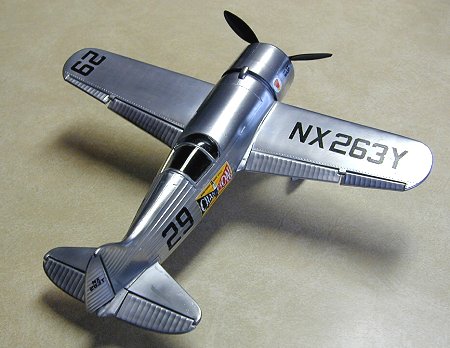 For some
reason, I decided to use a buffable aluminum paint on this model, so I opted for
Testors Buffable Aluminum. The rear portion of the prototype’s fuselage behind
the cockpit was covered with Irish linen fabric, so a shiny surface is not
needed here. But I wanted the rest of the model to have a reasonable shine
replicating the polished aluminum surfaces that Turner’s aircraft apparently
had. The first step was to prepare the surface, so I broke out my trusty can of
Brasso (Hey…I’m cheap, and so is Brasso!) and began polishing the model’s
surfaces (note: some kit plastics don’t seem to work very well with this
approach. Basically, the harder the plastic is, the better shine you will get if
you choose Brasso as your polishing compound).
For some
reason, I decided to use a buffable aluminum paint on this model, so I opted for
Testors Buffable Aluminum. The rear portion of the prototype’s fuselage behind
the cockpit was covered with Irish linen fabric, so a shiny surface is not
needed here. But I wanted the rest of the model to have a reasonable shine
replicating the polished aluminum surfaces that Turner’s aircraft apparently
had. The first step was to prepare the surface, so I broke out my trusty can of
Brasso (Hey…I’m cheap, and so is Brasso!) and began polishing the model’s
surfaces (note: some kit plastics don’t seem to work very well with this
approach. Basically, the harder the plastic is, the better shine you will get if
you choose Brasso as your polishing compound).
Once the surface was prepped, I shot the entire model with the Testors aluminum. Once the paint was dry, I then faced the buffing task. Here, the only way to do this is with a pair of white gloves, that allow you to grip the model while buffing it without getting your fingerprints all over the aluminum finish (and, boy, if you get seen doing this, you will NEVER live it down; talk about “geekdom” - having someone know you wear little white gloves while modeling will forever enshrine you in the Geek Hall of Fame, or worse!). Once I was satisfied with the buffed surfaces, I shot the landing gear and buffed them out the same way.
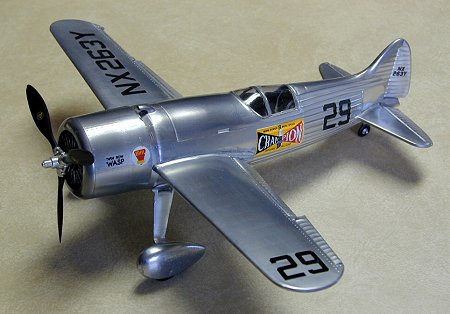 The model
was now ready for decaling. I have decided that, in general, buffed aluminum
surfaces on a model are best left uncoated to retain their shine. But this
creates a problem in that you have to be very careful when handling the model,
and it also creates some special steps for the decaling process. First, I
usually shy away from using setting solutions on natural metal finishes, as
these tend to react with the buffed surfaces and stain them. If you choose to
use these, make sure you blot up any excess solution that spills over from the
decal’s surface and onto the aluminum paint. To avoid the reaction problem, I
prefer just to use water, but one has to be just as careful to wipe up the
excess water since it will also stain the aluminum surface. The kit decals
seemed to settle down rather nicely on this model’s surfaces, so there appeared
to be no need for setting solutions this time. Again, this will vary with the
kit and the decals that are used by different manufacturers, so a trial and
error process is warranted here.
The model
was now ready for decaling. I have decided that, in general, buffed aluminum
surfaces on a model are best left uncoated to retain their shine. But this
creates a problem in that you have to be very careful when handling the model,
and it also creates some special steps for the decaling process. First, I
usually shy away from using setting solutions on natural metal finishes, as
these tend to react with the buffed surfaces and stain them. If you choose to
use these, make sure you blot up any excess solution that spills over from the
decal’s surface and onto the aluminum paint. To avoid the reaction problem, I
prefer just to use water, but one has to be just as careful to wipe up the
excess water since it will also stain the aluminum surface. The kit decals
seemed to settle down rather nicely on this model’s surfaces, so there appeared
to be no need for setting solutions this time. Again, this will vary with the
kit and the decals that are used by different manufacturers, so a trial and
error process is warranted here.
Once the decals were dry, I glued the landing gear to the fuselage, inserted the propeller into the engine, and glued the canopy on the model with white glue. Alas, I was finished (but now I have a model that I have to move around while wearing little white gloves: in Goose’s words, “This is NOT good, Maverick!!!”).
|
CONCLUSIONS |
If you can get your hands on one of these, this is an easy kit to build and a good diversion from military aircraft kits. It’s also not so big in 1/32 scale that you can’t find display space for it. I enjoyed the relatively quick build, and personally didn’t mind the lack of detail when I was constructing the kit. For as simple as it is, this is a well designed kit that looks good when assembled.
Be prepared to dry fit the parts and use a little filler on some of the seams. The natural metal finish could be problematic for some (including myself), but even an overall finish of regular aluminum enamel or acrylic paint should still produce an impressive model.

|
REFERENCES |
http://www.fiddlersgreen.net/aircraft/racers/laird/meteor/info/info.htm, 2002.
“Turner R-14 Meteor,” http://www.nasm.si.edu/nasm/aero/aircraft/turner.htm 2002.
“National Aviation Hall of Fame Inductee – Turner, Roscoe - 1975,” http://www.nationalaviation.org/enshrinee/turner.html
Copyright ModelingMadness.com. All rights reserved. No reproduction in part or in whole without express permission from the editor.
If you would like your product reviewed fairly and fairly quickly, please contact the editor or see other details in the Note to Contributors.
Back to Reviews Page 2016